In the first half of 2017, when far from all routers have moved to the 5 GHz band, I believe that a repeater (in other words, a signal repeater, or, as they say, “Wi-Fi amplifier”) must be dual-band.
After 3 weeks of testing, I dare to say that the TP-Link Re350 repeater is the best that I came across from devices of this kind. Yes, it is expensive, it does not support the total speed of the AC1750 (in my opinion, this is overkill for a repeater), but the price of the device is fully justified. If the price seems too high to you, you can save about 1000 rubles by buying a Re305 that is close in performance. It is less convenient, but in terms of speed it is almost as good as the Re350. And now in more detail.
Who needs a repeater?
If a Wi-Fi signal does not reach a part of your apartment (house, office) or it is very weak and its speed is unsatisfactory, you cannot do without a repeater. Despite the fact that on the network such devices are often called an amplifier wifi signal, in fact, this box just repeats it, in fact, throwing it further through itself. In other words, this is such a signal extender.
However, buying a Wi-Fi repeater is not always justified. As a rule, it is used as a last resort, when all other methods have not worked.
How to boost Wi-Fi signal without a repeater?
There are several standard tips for improving the quality of a Wifi network signal. I will describe them very schematically, because otherwise the material will be drawn to a separate article. Tips are arranged in order of complexity of implementation from the point of view of an ordinary user.
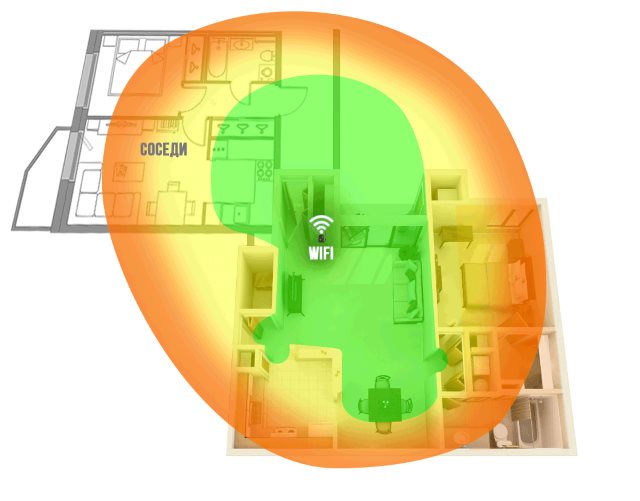
An example of improper router placement, taken from a directional antenna manufacturer's blog. As you can see from the illustration, your neighbors may have better Wifi coverage than you. Simply because the network equipment is placed incorrectly.
To understand how best to place the router, the easiest way to track your actions is to measure the signal in a problem place using special program, For example WiFi Analyzer. On the Signal Meter tab, you can see how the signal quality changes depending on your manipulations. In other words, they rearranged the router, went to a problematic place - measured the signal level.
- If the signal level is more or less normal, but you still have an unstable or low connection speed, then in WiFi program Analyzer can make sure that you are working on a free Wi-Fi channel. If your router is more than 3 years old and was inexpensive, most likely it operates at a frequency of 2.4 GHz. At this frequency, there are only 13 channels. Since your neighbors have the same router as you, most likely there are several more routers sitting on your channel. Let me give you just an analogy: each channel is a dedicated lane on the highway. If you are the only one using this channel, then the lane speed is limited only by the capacity of your car. In other words, if you can travel 60 km/h, you are traveling at that speed. If 120 km / h - go at full speed. However, if someone else is sitting on your channel, then this is tantamount to crossing an intersection - while red is on (packets are being transmitted by another device sitting on your channel), you will stand and wait.
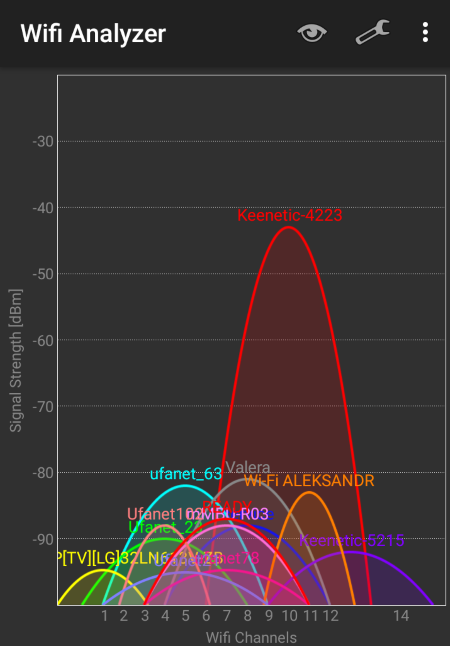
So, let's see what channel your router is on. Above is an example of a measurement in my home. If some channel is more or less free, it is worth switching the router to it, remembering that the edge channels (1,2..12,14) should not be selected - they are not always supported by the equipment and the signal itself is rather weak. How to switch the channel, the easiest way is to read the instructions for the router or search the network for an answer for your particular model. However, as we see above, it may happen that there are no free channels.
- The signal has not improved, the channel is clogged. What to do? Ok, it's time to update the firmware. If you have never done this, most likely the manufacturer's website has a firmware with bug fixes for a long time, and, what the hell is not joking, possibly amplifying the signal. As a rule, the manufacturer is in such a hurry to throw devices on sale that the firmware is very raw. Later, after the start of sales, the manufacturer can fix problems and holes for a long time and with taste. By the way, for a number of manufacturers, for example, for Zyxel, the firmware is updated automatically.
- If the first three points did not help, it's time to move on. It would seem that we are talking about repeaters. However, if your range is full, the repeater will help you little - it will also work on your channel, in fact, adding another device to an already loaded channel. Below I will develop this idea in more detail.
So, specifically to solve the problem of congestion in the 2.4 GHz band, there is a 5 GHz band with
- with channels of a different range;
- a large number of channels.
As a rule, good (read expensive) routers can operate in 2 bands, generating two Wi-Fi networks. For devices that are not demanding on speed, the 2.4 GHz band is suitable. It is also more long-range. But for high-speed devices that are sensitive to data transfer volumes (video, large file transfers), the 5 GHz band is more suitable. Majority modern devices support this range and work with it with pleasure.
Here, by the way, there is one funny nuance - in theory, the 5 GHz band is less long-range than 2.4 GHz, but the coverage of the new router can be much better than the old one. For example, an excellent dual-band router Zyxel Giga III, poor, but finishes off to a neighboring office, located at a distance of 50 meters along the corridor. Yes, the connection quality is so-so. But the router of the previous generation could not do this. So, by changing the router, you can kill two birds with one stone.
Myths about strengthening the Wi-Fi signal or what not to do
- One of the frequently repeated search queries is the phrase "download WiFi signal booster". This is impossible. The maximum that can be done is to download drivers for the computer's network card and update the router's firmware. All other advice will be harmless at best. At worst, they end up infected with a virus.
- Another myth is more powerful antennas. As practice shows, replacing the antenna with a longer one (and supposedly more powerful) does not lead to anything. Why: firstly, some of the antennas in modern routers are built into the case. Secondly, they are specially calculated for specific model and their lengthening and increasing the number does not change anything. Funny moment - the Chinese are very fond of poke a bunch of antennas, so that the router becomes like a spider. As practice shows, there is little sense from these embellishments. Thirdly, if you disassemble a specific plastic antenna, it often turns out that the metal core in it reaches well if up to a third of the length.

Everything else is purely a design trick to make the router seem powerful. The Chinese are especially guilty of this. By the way, there are special nozzles for turning omnidirectional router antennas into narrowly focused ones. But their installation has many nuances to recommend them to most users.
Ok, nothing helps. What to do?
We return to the idea of an amplifier for the router. There are two types of repeaters: single band, i.e. operating in the 2.4 GHz band only, and dual-band, also operating in the 5 GHz band. And the most interesting thing here is that dual-band not only “throws” the network of two bands further, but also solves the problem of channel congestion, being able to receive data in one band, and distribute it in another.
To illustrate this point, and explain why it's useful, we'll compare two WiFi repeaters. The first single-band Wi-Fi repeater, one of the most popular on the market, the Tp-Link Re850 model, and the new Tp-Link Re350, which, as mentioned above, works in two networks.

The setting is standard. We turn on the repeater in the socket, then we connect to the device either by wire or via Wi-Fi. If possible, it is better to connect with a wire, because overlays can occur with a wireless network.
Next, go to tplinkrepeater.net, after which we get into the master quick setup. We scan networks and see many networks in the 2.4 GHz band and one or two in the 5 GHz band. We select the networks we need, prescribe the password and reboot.
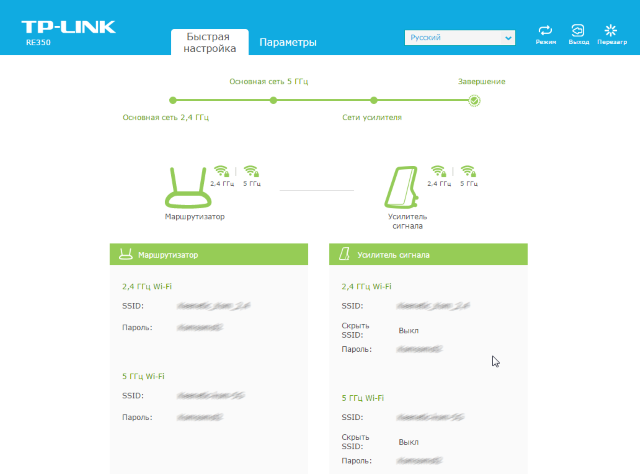
That's it, now we have two networks of the desired range, which overlap each other and amplify the signal.
Let's get to the tests. Since my router is set correctly at home and there are no special problems with signal coverage, we solve the issue radically - we go to a neighbor on the floor. As a result, between the router and the laptop on which speed measurements are taken, there are two thin walls and one solid brick wall, 40 cm thick. normal situation The router has no chance. The network is caught and immediately falls off. The measurement of speed is impossible in principle. Now let's see how the repeater does.
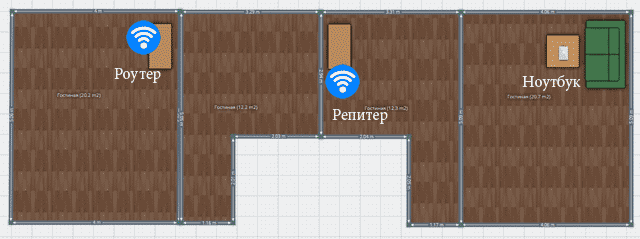
What is good about the Re350 model is that it has an LED indicator ring that shows the signal level. If the ring glows blue, the signal of the mother network is strong enough. If it glows red, the signal level is weak and the repeater should be moved closer to the router. In our case, we place the repeater just behind the main wall. After measurements in the same place, we connect a regular single-band repeater Re850. As a result, there is a distance of 5 meters between the router and the repeater and two walls - ordinary and capital. Before the laptop - another four meters and one ordinary wall.

We carry out measurements in two tools - the iPerf3 program, which determines the maximum speed over a local network, and the standard Internet speed meter Speedtest.net. In the first, we get a "clean" speed within the local network. So we exclude the influence of the provider and evaluate the net speed. In the second - we use the usual tool for many. I specifically excluded the Download speed, because in some cases my provider cuts it. But the Upload speed is not limited and therefore the values are close to iPerf measurements.
Measurements are taken on an HP ProBook G1 laptop. Router - Zyxel Kennetik Giga 3. On the main computer, Iperf3 is running in server mode, the computer is connected to a gigabit network card to the router. First, we connect to a 5-GHz network near the router and run a speed test. We have a good rate of 147 Mbps. Then we go to the starting position for three walls.
The first test - the Re350 repeater caught both networks from the router and broadcasts them further, in fact, sitting "clogging" its own channel in each range. We have the following numbers. Yes, the network at 5 GHz has quite good speed results. Notice how the regular Re850 behaves. Not only is the speed low, but it also floats (from 9.5 to 19 Mbps), which indicates signal instability. So Re350 will still be far-reaching even in the 2.4 GHz band. It would seem that this can be put an end to.
But, we will try the most interesting thing - to catch the network in one range, and forward it further in another. Update from 02/01/2017: In the comments and in the mail, we have already been asked several times to write in detail how to implement such a configuration. Especially for those who are faced with such a question, we recorded a video instruction:
Why is this needed - in fact, work on its own channel, the repeater will clog its own channel, which cannot be called a positive effect. Look at the picture below: 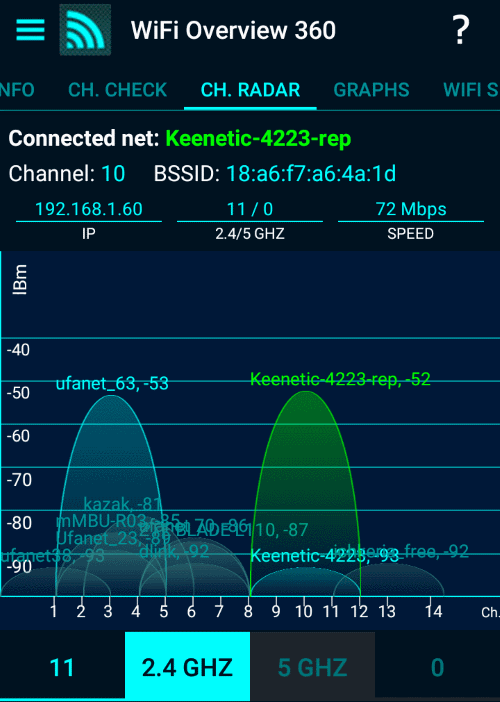
Yes, the signal has increased (green), but the repeater's network operates exactly on the same channel as the mother's. Those. The situation has gotten better, but not perfect. Let's try to get away from this problem.
So, the first measurement, we connect at 5 GHz, we forward the network further at 5 and 2.4 GHz. Normal indicators, slightly worse than when the repeater "forwards" both networks. And now the most interesting thing - we connect on 2.4 GHz (which has more coverage than 5 GHz) and forward the network to 5 GHz.
See what speed? Those. Confident reception of a 2.4 GHz signal allows you to maintain a high speed and forward it further to 5 GHz, moving away from 2.4 band interference. Thus, the combination of two ranges allows you to win great both in range and in data transfer rate.
Theoretically, it is possible to choose the location of the repeater in such a way that the 5 GHz network is caught confidently (after all, not all houses have solid brick walls a third of a meter thick) and then the network is forwarded in the 2.4 GHz band. This should give an even greater increase in speed, but in the conditions described, I was not able to achieve such a result. In any case, the measurements shown allow us to safely assert that a modern repeater should be dual-band, even if the router whose signal is going to be amplified only operates in the 2.4 GHz band. The performance gain is obvious.
Separately, it is worth noting the very design of the TP-Link Re350 - thanks to the antennas, the repeater catches and forwards the signal much better than its single-band counterpart. On the other hand, you have to pay for this with increased dimensions.
Just as fast but cheaper
Recently, the younger model Re305 has appeared in the line of TP-link repeaters, which differs in size and slightly less ease of use, however, it is similar in characteristics to Re350. Let's compare both models and see if the savings are justified.

At the beginning of testing, we measure the speed in the same room as the router. First, by connecting directly to it (in both bands, 2.4 and 5 GHz) and connecting through repeaters.
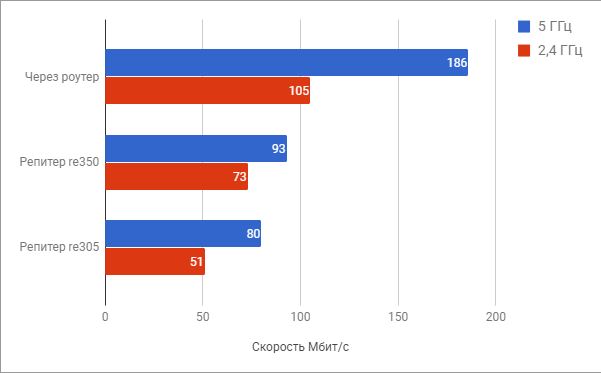
The first thing that catches your eye: Re350, despite the declared presence of a gigabit port, cuts the speed at the level of 100 megabits. Those. without a repeater, we get a speed of 200 megabits directly from the router, and through a repeater no more than a hundred. On the other hand, a repeater is usually used where the maximum speed cannot be expected. Against this background, the performance of Re305 is inferior only in the 2.4 GHz band, which, by definition, is unstable - the noisiness of the range affects.
Second conclusion: this picture clearly shows how the second device on the channel reduces it throughput. Without a repeater in the 2.4 GHz band, they had about 100 megabits, by connecting a repeater (read, by hanging another device on the channel), we reduce the speed by 1.5-2 times. This once again suggests that when setting up a network, it is imperative to look for a free channel.
Now we are leaving for the dead zone - a place where the net is caught, but extremely unstable. In this case, the router shows 4.6 megabits in the 5GHz band, and slightly better, but still insufficient, 13 megabits in 2.4 GHz.

The first situation: both repeaters catch networks of both ranges, forwarding them further. The result - the speed instantly increases to a comfortable 40-50 megabits in both ranges. The results for both repeaters are almost identical.
And now the most interesting thing - we set up the so-called “forwarding” mode - both repeaters catch only one network at 2.4 GHz and “forward” them further only at 5 GHz. As you can see, the result becomes 2 times better - both repeaters show their maximums, bringing the network speed to 100 megabits. Those. almost the same speed as if the router was standing right in the room.
As can be seen from the test results, the Re305 repeater is not much inferior to its older brother, but it is cheaper. Nevertheless, I still advise Re350 to buy, as it is more convenient for an inexperienced user. Why:
- The Re350 has a very handy indicator ring that makes it easy to find a place to place a repeater.
- The Re350 has better antenna placement. What's the matter: as you already read at the beginning of the article, the antennas must be placed vertically. No matter how your socket is located, in Re350 you will always be able to place the antennas correctly. In the case of the Re305, if the outlet is sideways (i.e. the plug is plugged in vertically), you will not be able to raise the antennas correctly, which will reduce the coverage area of the repeater.
- The Re350 has buttons on the side to turn off the device and turn off the light indication. Sometimes they are very necessary.
If none of these points is critical for you, you can safely buy Re305. In addition to the best price, you also get smaller dimensions.
If the repeater does not help
Repeaters are quite interesting devices, but they are not versatile enough. If you need to transmit a signal through a couple of solid walls, or to a remote location, the wireless signal may not be able to handle it. In this case, data transmission over conventional electrical wires can help. We have made a large number of such devices, detailing the pros and cons. In addition, we recorded a short video repeating this text:
WiFi for a country house and a cottage
In the event that you have a large country house or cottage, or you want to “wire” fast Internet into a summer gazebo, an ordinary repeater, even a very good one, may not help you. In the case of really large areas, I would advise you to take a closer look at the Netgear Orbi. Despite the more than impressive price (about 23 thousand rubles), this is the simplest and most productive in terms of speed of the ways I know to conduct the Internet around a country house.
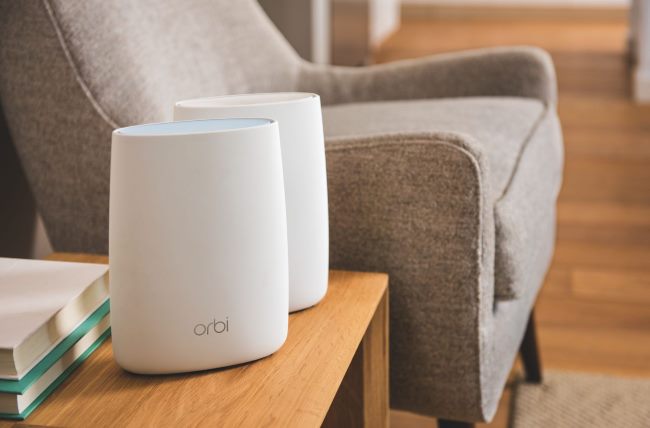
The kit contains two devices, one of which works as a router (a cable from the Internet provider is inserted into it), and the other works as a high-performance repeater. The connection between the devices, according to the manufacturer, is carried out at a speed of 1733 Mbps. Even in cases where the actual speed is less than two times, the remaining performance is still enough to provide fast Internet to any devices around. And Orbi's coverage is just huge.
And yes, if you suddenly do not have enough network coverage (although I hardly imagine such a situation, unless you have some kind of castle, and not a house), you can buy another repeater and add it to the system. The only thing is that it will not be possible to make a chain from repeaters - an additional device will also cling to the central station.
With the growing popularity of WiFi networks, users are faced with problems associated with limiting the range of an access point or router. Indoors, a standard router provides a range of no more than 45 meters.
The range and quality of communication largely depend on the obstacles in the signal path and the material from which the walls are made. For example, reinforced concrete structures reduce the signal level by 20-25 decibels. This means that the signal will practically not pass through two reinforced concrete walls.
The obvious solution is to increase the power of the router. In this case, the problem is solved, but only partially, since it is impossible to increase the power of the radio transmitter indefinitely. That's why the best option is the application of multiple points receive-transmit signal, the so-called repeaters.
On English language this word sounds like "Repeater", which means "repeater" in translation. The repeater works as follows. After applying voltage and subsequent configuration, the WiFi repeater connects to the base access point and transmits (amplifies) the signal. Network parameters such as network name and other settings remain unchanged.
HOW TO CHOOSE THE RIGHT
At Wi-Fi selection The repeater should be guided by two parameters. The first is the features of the room where the device is installed, and the second is the area, layout and material from which the walls are made. It is also worth taking into account specifications wifi repeater A. Let's start with the technical specifications.
The main parameters should include:
Signal transfer rate.
It all depends on the standard, consisting of a number and a symbol. The number is unchanged - 11, but the letter next to it can change - "b", "g" and "n".
Frequency range.
There are three types - 2-band, 5000 MHz and 2400 MHz.
Power and sensitivity (dBm) of the transmitter.
Modern WiFi repeaters are mostly 2-band and have the following signal transmission standards - IEEE (802.11n, 802.11b and 802.11g).
The subtleties of choice in relation to the type of room.
The choice of a WiFi repeater should be carried out taking into account the characteristics of a particular object. So, for a house with one floor or an ordinary apartment, a small transmitter with a built-in antenna is suitable. But even with the correct installation and configuration of the router, the signal is unlikely to pass one or two rooms, so you can’t do without WiFi connections amplifier.
In large buildings, cottages with two floors and office premises, it is worth using higher power repeaters equipped with external type antennas. In this case, you can achieve a stable signal and not install additional equipment.
What else to consider when choosing?
To improve the efficiency of the repeater, it is worth paying attention to the technical Wi-Fi performance amplifier. The optimal operating frequency range is 5000 and 2400 megahertz. Their peculiarity lies in the possibility of implementing different connection schemes. At a frequency of 5000 MHz, you can count on best quality receiving and transmitting information.
The disadvantage is a smaller coverage area when compared with a device with a frequency of 2400 MHz. That is why the scheme is more often used when the repeater is combined with a router and operates at a lower frequency (2400 MHz). As for retransmission, it is conducted at 5000 MHz.
When implementing such a scheme, two problems can be solved - to increase the range WiFi networks, leave the information transfer rate at the same level and reduce interference from other devices in the coverage area. If equipment with a frequency of 2400 MHz is already installed in an office or apartment, it makes no sense to buy a 2-band WiFi repeater.
SETUP AND CONNECTION
There are two main options for setting up a wireless repeater:
- using the WPS button;
- or web interface.
The first setting method is not always available and depends on the model. With WPS support, you should act as follows - turn on the repeater, wait a certain time before it boots up and press the WPS button on the amplifier and WiFi router. In this case, the repeater automatically detects the network and enters the operating mode.
If WPS is not available or if there are problems with automatic connection, you can go to the second option - configuration using the web interface. The repeater has a special Ethernet connector, and a patch cord is included with the device, allowing you to connect to a laptop or PC.
How to set up a repeater in the absence of WPS?
To do this, the repeater is connected to a computer. IN address bar The browser enters the IP address of the device, which is usually indicated on its body, after which the user enters the settings menu.
The essence of further settings of the repeater is to specify the MAC address (BSSID) of the main access point, as well as its security settings. Because the procedure for different models may vary, it is better to refer to the instructions for a specific device. Once the repeater setup is complete, the instrument will reboot and operate normally.
Before installing a WiFi repeater, it is advisable to check the range of the amplifier in the room. The easiest and most affordable way is to use a smartphone with installed software (WiFi Analyzer). The program allows you to check the signal strength at each desired point and determine with high accuracy the place to connect the repeater. The latter is set in the region of the most stable reception.
With antennas on WiFi repeater it is important to choose their position correctly, taking into account the subtleties of the signal distribution in the room. If the router and repeater are on the same floor, vertical orientation is optimal. When installed on different floors - in a horizontal plane.
The number of amplifiers required to create a stable signal is determined individually. As a rule, one repeater is enough for a house or apartment.
OVERVIEW OF POPULAR MODELS
Currently, the products of TP-Link and Xaomi are in the greatest demand.
TO popular models TP-Link is worth mentioning:
- RE200 is a 2-band repeater with an original design, operating on 2400 and 5000 MHz. Features are the presence of a built-in indicator and media adapter for Smart TV;
- The RE350 is a Class A repeater operating on two bands. Features - the presence of 2 antennas, as well as the presence of an indicator that reflects the signal level (helps with choosing a place to connect). The speed of information transfer via Wi-Fi (for a local network) is 1 Gb / s. It is possible to set up the repeater using a smartphone. An important plus is its compactness;
- TL-WA850RE. This compact 2400 MHz repeater is equipped with two antennas and transmits data at up to 300 Mbps (11n).
WiFi amplifiers from Xiaomi are no less in demand. The main advantages are the original design and affordable price. Among the most popular, it is worth highlighting the Xiaomi Mi WiFi Amplifier model equipped with a USB interface.
The repeater is configured in automatic mode, and the amplifier is connected to the router with via USB connector. Used to increase power wifi signal and in rooms with insufficient reception quality.
All in all, a WiFi repeater is a useful, compact and efficient device for amplifying the signal and creating a stable network in an apartment, house or office. In addition, it is indispensable when building a wireless video surveillance system.
The advantages of this technology are ease of setup, low cost and expansion of the coverage area of the home (work) WiFi network. Of the shortcomings - a decrease in the data transfer rate (up to 10-15%). By the way, this can be critical when using WIFI camcorders. On sale can be found as powerful amplifiers with 2-3 antennas, and weaker devices with one antenna.
© 2010-2017. All rights reserved.
The materials presented on the site are for informational purposes only and cannot be used as guidance documents.
Cellular communication has firmly become part of the everyday life of almost every inhabitant of the earth, but not everyone can take full advantage of it. Even if you have a cell phone with a connected SIM card and a positive balance, you can remain out of reach for other subscribers.
Poor communication can be due to various reasons:
- remoteness base station operator from your premises
- Presence of natural barriers. It can be a forest belt or a mountainous area on the path of the GSM signal.
- The location of your premises in a hard-to-reach place. For example, on the basement floor or in a sheathed metal hangar
- In the city, the quality of the signal is affected by dense urban development and overload of the operator's base stations.
But not everything is so sad. For more than a decade, you can see amplifiers for sale in online stores. mobile communications- repeaters. The cost of a good kit can range from 10,000 to 25,000 rubles, which is commensurate with the cost of a tablet or smartphone. In order to spend your money wisely and acquire good repeater, we made a rating of amplifiers cellular communication medium level with a coverage area of 800 sq.m, operating at a frequency of 900 MHz.
Full coverage of the signal coming from the amplifier is provided only if there are no obstacles in the range. In order for the signal to propagate over the entire area, the following conditions must be met:
- The receiver is installed in a location with a good signal.
- Minimum cable length selected
- Operator base station provides coverage at your site
- There are no metal and concrete barriers.
Using the search, we found several signal boosters that can improve cellular communication in a room of more than 800 sq.m.
Tested amplifier models:
- Picocell 900 SXA
- StrongCall Мх70
These models are able to divide the signal into several zones.
Testing will be carried out according to the following parameters:
- output power
- Gain
- Automatic Gain Control (AGC)
- Basic equipment
- Price.
So let's get started! Let's consider everything in order.
1. Output power
This parameter directly affects the created coverage area. If the output power indicator is low, good coverage will not be seen.
Output power is measured in dBm (dBm) and mW. For the convenience of calculations, we will take one value as zero in order to carry out calculations relative to it. So, if we take 1 mW as the zero level, then such a unit appears as dBm (1 mW = 0 dBm).
Almost all the devices under consideration have the power indicated in dBm, except for MWS-EG-B23 (expressed in mW) and StrongCall Mx70 (indicated in both mW and dBm).
On paper, all applicants have an output power value exceeding 20 dBm, which is quite enough to cover an area of 800-1000 sq.m. But we are not just comparing the values specified in the instruction. We have the technical ability to check the actual value of the output power. Output power and distortion measurements will be taken with a spectrum analyzer Rohde & Schwarz FSH3.
The summary table shows the data obtained during testing (for your convenience, the value of the output power is given in both mW and dBm):
Table #1
| Device | Declared output power, dBm/mW | Actual, dBm/mW |
| 20/100 | 17/50 | |
| 20/100 | 19/79 | |
| 27/500 | 27/500 | |
| Picocell 900 SXA | 20/100 | 20/100 |
| 23/200 | 23/200 | |
| StrongCall Мх70 | 20/100 | 20/100 |
| 27/500 | 26/398 |
As you can see, not all models have the declared output power "friendly" with the actual one. The models turned out to be honest: VectorR-810, Picocell900 SXA, MWS-EG-B23 and StrongCall Mx70.
The most honest and safe for the operator's base station are the StrongCall Мх70 and Picocell 900 SXA amplifiers. They get the highest score.
Table number 2
2. Gain
The gain factor is one of the main parameters that indicates how much dB the repeater can amplify the output signal relative to the received one. To check this, it is enough to install on a smartphone with a platform android program netmonitor. By doing this, we will see the signal level in the room and be able to determine the location of the operator's base stations. A bad signal will be characterized by a value of minus 90-110 dB. A good signal level is characterized by a value of minus 65-75 dB.

We tested the declared indicators of the contestants. The measurement of gain and uneven frequency response was carried out by a vector network analyzer "OBZOR-804/1". The data obtained are reflected in table No. 3.
Table #3
| Device | KU according to the passport, dB | KU actual, dB |
| 70 | 66 | |
| 70 | 68 | |
| 75 | 72 | |
| Picocell 900 SXA | 70 | 69 |
| 65 | 64 | |
| Strong Call Мх70 | 70 | 69 |
| 70 | 67 |
Unfortunately, not all contestants passed this test. Test leaders are once again StrongCall Mx70 and Picocell 900 SXA. At the current stage, an amplifier from MediaWave has joined them. The repeaters of these brands showed actual CG indicators that are closest to the declared ones. 1 dB difference can be attributed to the error.
Let's grade:
Table No. 4
| Device | score |
| 6 | |
| 8 | |
| 7 | |
| Picocell 900 SXA | 9 |
| 9 | |
| StrongCall Мх70 | 9 |
| 7 |
3. Automatic Gain Control (AGC)
When choosing a repeater, this indicator cannot be ignored. It is very important, but manufacturers do not provide reliable information on it. The higher the AGC value and response speed, the more efficient and safer the amplifier will operate for the operator's base station.
Table number 5
| Device | AGC according to the passport, dB | AGC actual, dB |
| 45 | 30 | |
| 15 | 15 | |
| - | 30 | |
| Picocell 900 SXA | 25 | 25 |
| - | 40 | |
| 45 | 45 | |
| 30 | 30 |
After reviewing the documentation for the Vector R-810 and MWS-EG-B23 models, we did not find information on gain control in the technical specifications. But in fact it is.
In addition to the AGC value itself, it is important that the system automatically works and does not overload the operator's base station once again. The AGC indicator on repeaters with an output power of 100 mW should have a value of about 40-45 dB, which will allow the equipment to work comfortably without interfering with the operator's cells.
The AGC index of Anytone-700 and Picocell 900 SXA is low, but it is also 2 times higher than that of Vegatel VT2-900E, which can adversely affect the interaction with the operator's base station.
As for the Aileron AE-970 model, its AGC indicator is overestimated by 1.5 times. In addition, the operation occurs with a noticeable delay.
Vegatel VT2-900E repeater has automatic gain control. The passport value of AGC is confirmed by our tests, but the indicator itself is very low, which, again, worsens the interaction with the base station.
Vector R-810 and MWS-EG-B23 surprised us - we couldn't find AGC information. But in fact it is. If the device from MediaWave has this indicator in the norm and is 40 dB, then for the Vector R-810 model it is low (30 dB).
Only the Russian-made repeater Strong Call Mx70 passed the test. And the AGC indicator itself of 45 dB is true, and the operation occurs instantly. In testing on this indicator, the StrongCall Mx70 amplifier won a confident victory.
Table No. 6
4. Basic equipment
As a rule, the price of the amplifier does not include the cost of additional accessories, which are mandatory components of the system.
Integral components of the amplifying system:
- external receiver. It receives a signal from the base station and transmits it to the repeater
- Internal antenna. Creates indoor coverage area
- Communication cord. Connects the device to an external and internal antenna
- RF connectors. They are wound onto a communication cable for further connection with receivers.
On the Internet, we found complete sets of repeaters participating in testing. Let's try to disassemble the basic equipment of each of them.
Aileron AE-970- 10 600 rubles
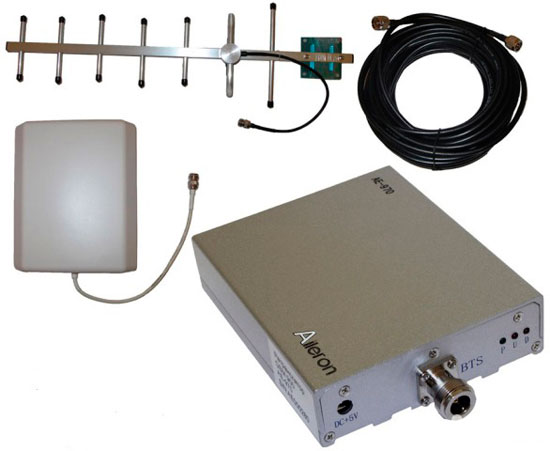 Options:
Options:
- External directional antenna type Yagic KU 11 dB
- Internal panel antenna ANT-65 with 6.5 dB gain
- Communication cable 5D-FB10 meters
- Power adapter.
The wire has a loss of 19.6 dB at 100 m. Good equipment, but the attenuation on the cable is suspiciously high.
Vegatel VT2-900E- 22 800 rubles

Options:
- External directional antenna type Yagic KU 12 dB
- Receiver internal, pin with KU 2-4 dB
- Communication cable 3D-FB10 meters
- External power adapter.
The signal loss is 37dB at 100m. That's a lot. Such losses can adversely affect the quality of work. It is possible that there will be no amplification effect at all.
An internal pin-type receiver is a poor choice. With a low gain, it will not be able to create a large coverage area. In addition, you will be forced to place the amplifier in the area where you need to boost the signal. During installation, this will cause serious problems.
23 600 rubles

Options:
- External directional antenna type Yagic KU 13 dB
- Antenna internal whip with KU 2.5 dB
- Communication wire 15 meters
- Built-in power adapter.
Cable loss - 27.2 dB at 100 m. Not as bad as the Vegatel VT2-900E, but still not good. The slightest obstructing factors will knock down the signal or completely drown it out.
Again, the pin-type receiver is not the best choice. Especially for mid-range amplifiers like the ones we're looking at right now.
The power supply is built into the case, and this is another minus. If it fails, there will be serious difficulties with the repair. You can’t just buy a new PSU and quickly change it.
Picocell900SXA- 26 940 rubles

We did not find ready-made kits, so we will select them ourselves, guided by the manufacturer's price list.
Options:
- All-weather directional antenna with 11 dB gain
- AD-806-01P indoor panel antenna with 6 dB gain
- Cable assembly 5D-FB10 meters + 5 meters
- External power adapter.
Cable loss - 19.7 dB per 100 m. Not a bad package, but the attenuation index still goes off scale.
14 500 rubles

Options:
- All-weather panel antenna with 9 dB gain
- AD-806-01P indoor panel antenna with 9dB gain
- RG45 cable assembly 10 meters + 5 meters
- External power adapter.
Signal loss per 100 m of cable - 19.6 dB. A good package is again summed up by the attenuation on the wiring.
StrongCall Mx70- 16 300 rubles
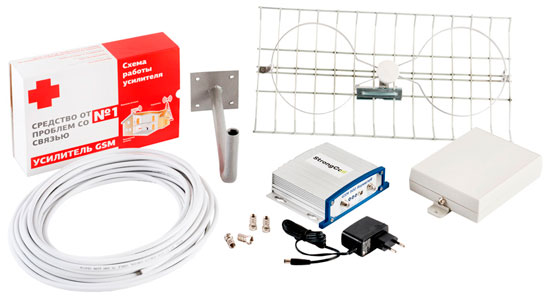
The set of equipment is called "Profi Mx70".
Well, let's see what the domestic "pro" is.
Options:
- All-weather directional receiver with 10 dB gain
- Arp900 indoor panel antenna with 7 dB gain
- Communication wire Sat-50 10 meters + set of connectors
- Bracket for mounting an external receiver
- External power adapter.
Cable loss - 18.7 dB at 100 m. Good equipment, and losses are not critical.
22 100 rubles
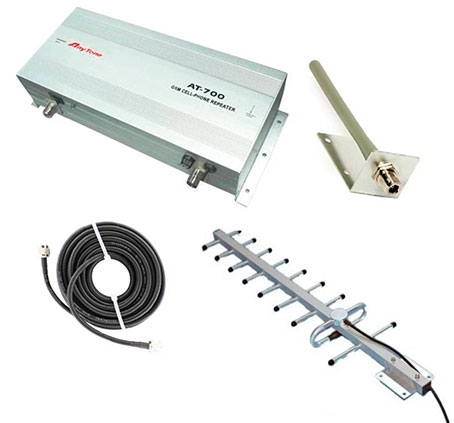
Options:
- All-weather directional antenna with 13 dB gain
- Internal whip antenna with KU 7 2.5 dB
- Communication cable 15 meters
- External power adapter.
Unfortunately, the sellers of the equipment could not tell us the brand of cable used. Again, a pin receiver, as mentioned earlier, is not the best option.
Table number 7
We gave low marks to the Vector R-810 kit because of the built-in power supply and high loss cable, as well as the Vegatel VT2-900E model, which uses a cheap cable that is characterized by high losses. In addition, a low-gain internal whip antenna is included. Also low marks were given to the repeater Anytone-700. Like the two previous models, it was pierced on the internal whip antenna. The StrongCall Mx70, Aileron AE-970, MWS-EG-B23 and Picocell 900 SXA models won this competition, which are equipped with internal high-gain panel antennas. The Profi Mx70 set received an extra point for having the familiar low-loss 75 ohm satellite cable in the kit.
5. Cost
The cheapest kits (prices are given above) are models from Aileron and MediaWave. Our "heavyweight" was Picocell. "Profi Mx70" - the golden mean.
The scores are shown in Table 8 below:
Table No. 8
| Device | The cost of the set, rub. | score |
| 10 660 | 10 | |
| 22 800 | 6 | |
| 23 600 | 6 | |
| Picocell 900 SXA | 26 940 | 5 |
| 14 500 | 9 | |
| 16 300 | 8 | |
| 22 100 | 6 |
Ratings are posted. It's time to sum up the overall results.
Results
Table No. 9
Winner according to the results of all tests and comparisons became StrongCall Mx70 repeater Petersburg company "Quartz".
The amplifier has high and, most importantly, honest specifications. There is no negative impact on the base station. The only thing in which this device lost to some other contestants is in the selling price.
Cellular communication has firmly entered our lives and its absence is extremely inconvenient for a modern person. Problems with poor coverage of the territory by cellular networks are known to all. The most convenient and fastest solution is to use a cellular signal amplifier based on a repeater. However, the existing variety of brands and models of amplifiers confuses the inexperienced buyer. Therefore, we decided to compare ready-made kits to improve the quality of cellular communication. To participate in the rating, we have selected seven of the most popular amplifier kits in Russia for self installation V country house. Each of the kits includes a repeater and antennas with a cable necessary for its operation. We hope our rating will help you in your choice.
Text: Ivan Yudin, independent expert, candidate of technical sciences
The most important thing in a cell signal booster is GAIN, which is measured in decibels (dB). The higher it is, the better amplifier will cope with the task - to amplify the cellular signal. When the signal from the base station mobile operator passes to the subscriber, then it is first amplified by an external antenna, then by a repeater, and then by the internal antenna of the set. Thus, it is important for the buyer to know the total gain of each set under consideration. If the gain is small, then there is no need to talk about any acceptable improvement in the quality of communication.

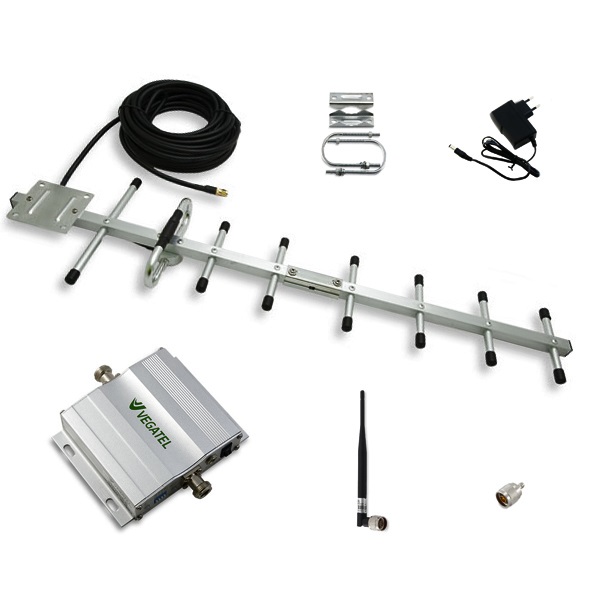
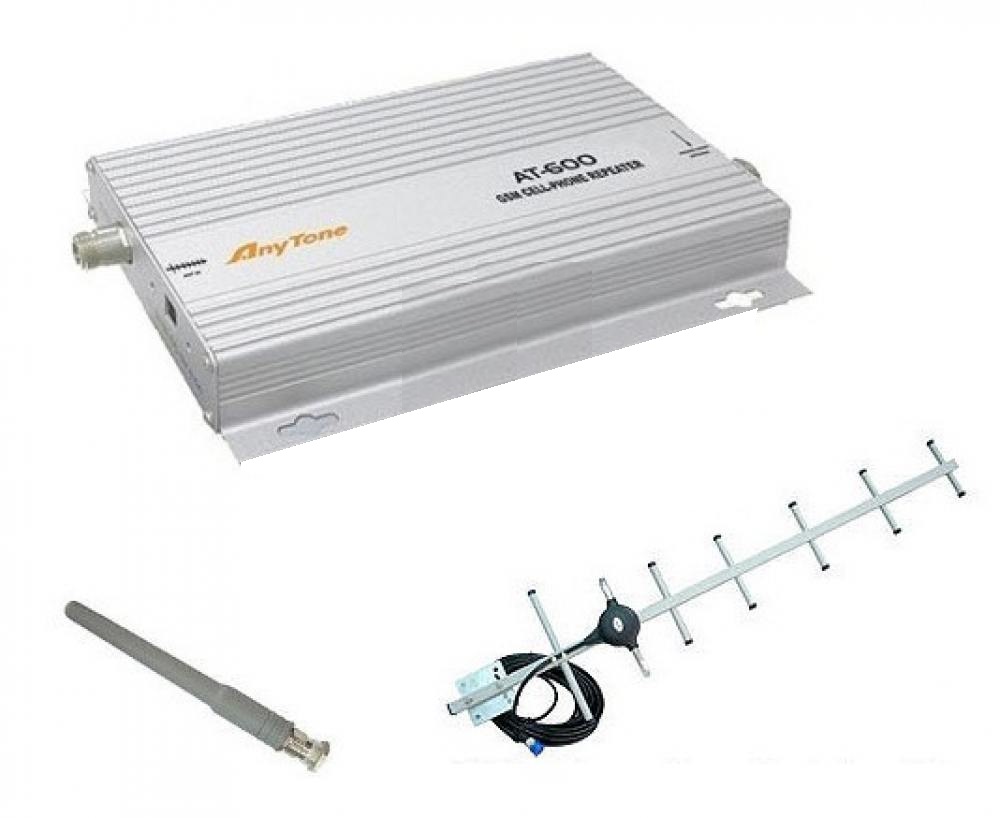
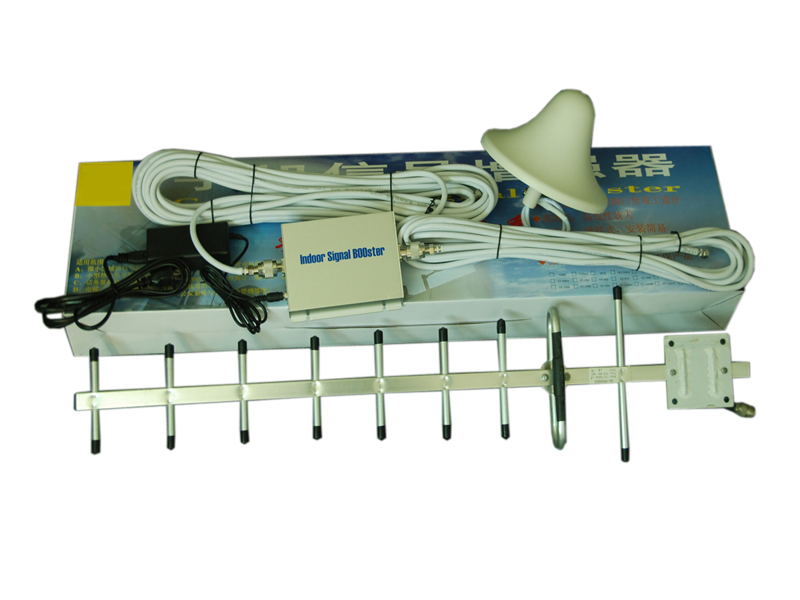
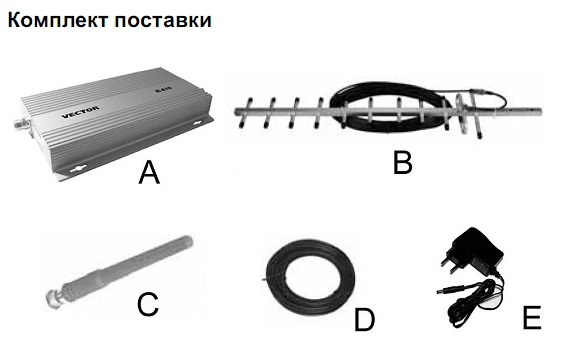
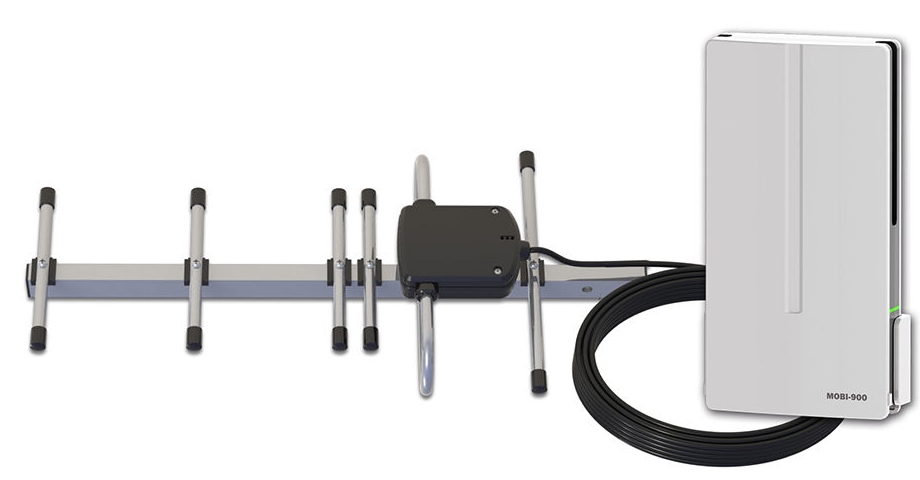
We put it as the second most important parameter for the amplifier PRICE. At the same time, the greater the gain of the amplifier at a lower price, the more efficiently each ruble is spent. Let's say right away that the gains and prices of amplifiers various models differ from each other almost 2 times. Therefore, only their direct comparison in one table will make it possible to understand how justified the price of each of them is.
Kit Efficiency = Gain (dB) / Cost (RUB)
Obviously, the higher the effectiveness of the kit, the more profitable you made a purchase, paying less money for a larger gain. The results are shown below in the graph and in the table.
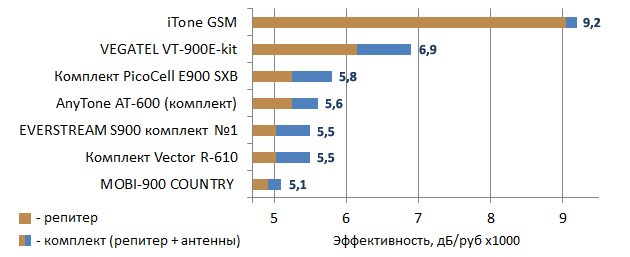

As a result of such a direct comparison, two clear leaders emerged in our rating: iTone GSM-10V and VEGATEL VT-900E-kit kits. Their efficiency turned out to be 1.5-2 times higher than that of competitors.
Hello! Let's talk about repeaters in this article. Will try plain language tell what kind of devices they are, why repeaters are needed, and how from the usual wifi router and make a repeater with your own hands.
To begin with, a Wi-Fi repeater is a separate device. They are also called repeaters, or repeaters. This article will focus on Wi-Fi repeaters. As I already wrote, these are separate devices that have one task - to amplify the signal of an existing WiFi networks.
Many manufacturers that make routers also make repeaters. For example, such popular companies as: Asus, Tp-Link, Linksys, Netis, etc. You can find repeaters in almost any computer equipment store, or in an online store. As I wrote above, they can be called differently: repeaters, repeaters, or repeaters. They also look different. They are usually very compact. But, there are also routers similar to Wi-Fi. Here, for example, is a compact Tp-Link repeater:
But the TP-LINK TL-WA830RE repeater looks like a regular router:

In fact, there are a lot of repeaters on the market. All of them are different, both externally and in their functionality. Well, of course, the price. I think that with the choice of problems will not be.
The most interesting thing is that for some reason these devices always remain in the shadows. Yes, of course, they are not as popular and in demand as Wi-Fi routers, but in many cases, they are simply not replaceable. That's how many situations happen when, after installing a router, Wi-Fi is not available throughout the house or office. Well, it's a common situation, and very common. It is precisely in such cases that repeaters are simply not replaceable. And instead of spending a relatively small amount on a repeater, users begin to think of something: pull the router and all the cables closer to the center of the house, buy more powerful antennas, make some homemade amplifiers for WiFi (no or very little benefit) etc.
But there are repeaters: they bought it, plugged it into the outlet in the room where the Wi-Fi network is still there, but the signal is no longer very strong, and that's it, the problems are solved.
So what to do, if i have a dual band router (two Wi-Fi networks 2.4GHz and 5GHz)? Everything is very simple, if you have, then you need an appropriate repeater that can simultaneously strengthen a Wi-Fi network in two bands. I wrote about such a model in the article: "".
What is a Wi-Fi signal repeater, we have already figured out. There are two more questions left to answer:
- How do Wi-Fi repeaters work?
- And what does a router in Wi-Fi repeater mode mean?
Wi-Fi repeater: how does it work?
I'm here to make a small schematic, let's first see it:
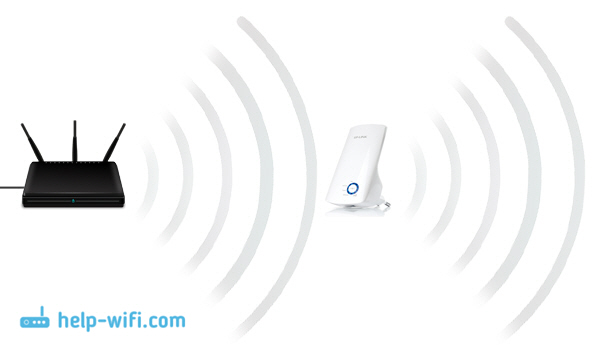
I'm not a strong artist, but the scheme seems to be understandable. We have a main Wi-Fi router that distributes the Internet via Wi-Fi. Everything is set up and works great. But, here Wi-Fi catches not throughout the house. For example, there is still Wi-Fi in the hallway, but in the kitchen the signal is already very poor, or the devices do not catch the Wi-Fi network at all. We take a repeater and turn it on in the hallway.
If necessary, even multiple repeaters can be used. I wrote in detail on setting up such a scheme in the article.
What does it do: it receives a Wi-Fi signal from the main router, and transmits it further. It turns out that in the kitchen we already have a very good signal home network. He relays wireless network (that's why it's called a repeater). The repeater simply acts as an amplifier. Its main task is to accept a certain Wi-Fi network and pass it on.
Some important points when using a repeater:
- If you use a repeater, then the Wi-Fi network will remain exactly one (and this is good). I explain: your main router distributes a network called "My_WIFI" (which does not catch all over the house). We install a repeater, set it up (as a rule, all the settings come down to pressing the WPS buttons on both devices at the same time), it copies your network information, and creates exactly the same network. With the same username and password.
- Your devices will automatically, imperceptibly for you, connect to the network, the signal from which is stronger. For example, the main router is installed in the bedroom, and the repeater is in the hallway. This means that if you are in the bedroom, you will be connected to a Wi-Fi router. And if you go to the hallway, then your phone will automatically connect to the repeater. You won't notice it.
- All devices: phones, computers, laptops, tablets, TVs, etc., that will be connected to the main router, or repeater, will be on the same network. This means that we can customize local network, in which all devices will participate. Or, for example, set , and . In this case, the computer can be connected to the router, and the TV to the repeater.
Router in repeater mode
A regular Wi-Fi router can act as a repeater. True, not all models are able to do this, and not all manufacturers have this mode done well. If you have an extra router that is lying idle, then it is possible that it will be able to work in repeater (amplifier) mode without any problems, and increase the range of your Wi-Fi network. All you need to do is to configure the router to work in the desired mode.

I have already checked the operation of the "Amplifier" mode on routers from two manufacturers: Asus And ZyXel. More specifically, on the models: Asus RT-N12+ and ZyXEL Keenetic Start. You can see the instructions for, and use. Both devices are configured very simply and clearly. Work stably, checked.
But, this possibility is not available on all routers. As far as I understand, there is no repeater mode on popular TP-Link routers as such. There is only bridge mode (WDS), this is a completely different mode of operation (and the purpose is different). Only access points from TP-Link can act as a repeater. WITH D-Link routers I also haven’t figured it out yet, there probably also isn’t a mode that would allow the router to simply strengthen the Wi-Fi network (checked DIR-615 / A, I don’t know how it is with other models).
A Wi-Fi signal repeater is a really useful device
Well, you see, it's a useful thing. But, for some reason, faced with the problem of a weak Wi-Fi network signal in their home, not many people solve the problem by buying and installing a repeater. But on the other hand, they simply ask a huge number of questions like: “I can’t catch Wi-Fi in the bedroom, what should I do?”, “Very weak Wi-Fi signal, help”, “what settings should I change in the router so that the Wi-Fi signal is stronger?" etc.
As a rule, if the signal is bad, then this cannot be fixed by setting the router itself. You just have a large area of \u200b\u200bthe house that the router cannot physically cover with a signal. And also there are different walls, and interference. In such cases, installing a repeater solves all problems.
As for a regular router that can act as a repeater, I advise you to configure such a scheme only if you already have a router itself. If you are going to buy, then it is better to immediately buy a real repeater. A device that was created specifically to expand the zone of a Wi-Fi network.
